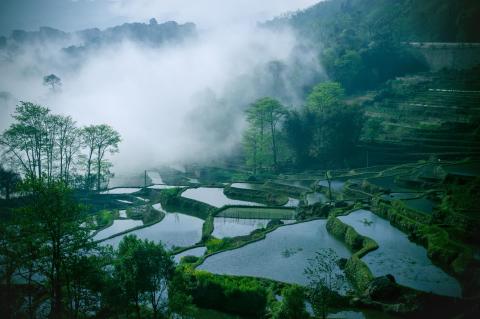Green Hills and Clear Waters Are Gold and Silver Mountains: Azheke Village



Deep within the rugged Ailao Mountains, at the eastern edge of the Hengduan Mountain Range in Yuanyang County, part of the Honghe Hani and Yi Autonomous Prefecture in Yunnan Province, layers of terraced fields resemble mirrors of various shapes, embedded in the endless green mountains and rivers. Traditional Hani "mushroom houses" appear faintly among the mist-shrouded trees. From the foot of the mountain to the peak, which rises nearly 3,000 meters above sea level, these terraces extend, with over 3,700 levels seeming to stretch all the way to the clouds. Hidden within the white clouds are crisscrossing paths and a few scattered households.
This is Azheke Village, a part of the World Heritage-listed Honghe Hani Rice Terraces Cultural Landscape, located in Yuanyang County. With its well-preserved "forest-village-terrace-water system" cyclical ecosystem, unique Hani traditional dwellings, and rich Hani cultural heritage, Azheke is one of the five key villages that were central to the successful inscription of the Honghe Hani Rice Terraces as a World Heritage Site.

Before the successful World Heritage designation of the Honghe Hani Rice Terraces in 2013, despite its breathtaking scenery, Azheke was little known. Its relatively isolated location, along with a traditional yet inefficient rice farming system, hindered the village's economic development. Half of the village's labor force had to leave to work elsewhere, and the village suffered from noticeable depopulation.
For some farmers, the terraces are both a source of wealth and a limitation. The rugged terrain surrounding the village lacks flat, expansive land, making it difficult to use modern farming equipment. Low yields and minimal profits discouraged many villagers from continuing to farm the terraces, putting the protection of this heritage at risk.
In response, the "Azheke Plan" was developed by Professor Bao Jigang's team from Sun Yat-sen University. The plan, based on heritage protection principles, aims to turn the area's unique ecological resources into "grain silos" and "treasure chests" for the local people. Centered around the concepts of "home, people, and land," the plan promotes tourism while preserving the terrace landscape, natural environment, and cultural heritage. This initiative has improved living conditions and increased the incomes of villagers, breathing new life into the ancient village and its thousand-year-old terraces.

The plan involves 65 households contributing their traditional dwellings, terraces, residency, and household registration in exchange for shares in the tourism project. Dividends are distributed to encourage villagers to protect their traditional homes, farm the terraces, and maintain residency in the village. The local government of Yuanyang County and the collective of Azheke Village jointly established the Azheke Village Collective Tourism Company, which organizes villagers to improve the environment and manage tourism services. Villagers oversee the company's operations. All of the company’s revenue goes back to the village, with dividends allocated as follows: 40% for the protection of traditional dwellings, 30% for terrace preservation, 20% for residency, and 10% for household registration. This system incentivizes villagers to repair and maintain traditional homes, farm the terraces using traditional methods, and stay in the village, thus preserving the authentic atmosphere of the community.
It is reported that the Hani Terrace Heritage Area distributes over 13 million yuan in various subsidies annually, benefiting more than 20,000 people. Additionally, Yuanyang County has promoted the integrated farming system of "rice-fish-duck," which has transformed the traditional single-crop rice farming into a diversified income source that includes red rice, terrace fish, terrace ducks, and duck eggs. They have also initiated organic certification for red rice and introduced a range of products such as red rice porridge, red rice tea, and red rice wine, enhancing the brand image and market competitiveness of local agricultural products.
Thanks to over a decade of efforts by Honghe Prefecture, the key heritage elements of the Hani Terraces—forests, villages, terraces, and water systems—have been systematically protected, traditional culture has been fully preserved, and the heritage value has been utilized reasonably. The heritage's functionality has been continuously sustained, and the sense of happiness and fulfillment among the villagers has significantly improved. Azheke Village has truly realized the concept of "green hills and clear waters are gold and silver mountains."
Honghe Prefecture's integrated approach to protecting the ecological and cultural systems of the Hani Terraces has paved the way for a high-quality development model that achieves both World Heritage protection and rural revitalization.









